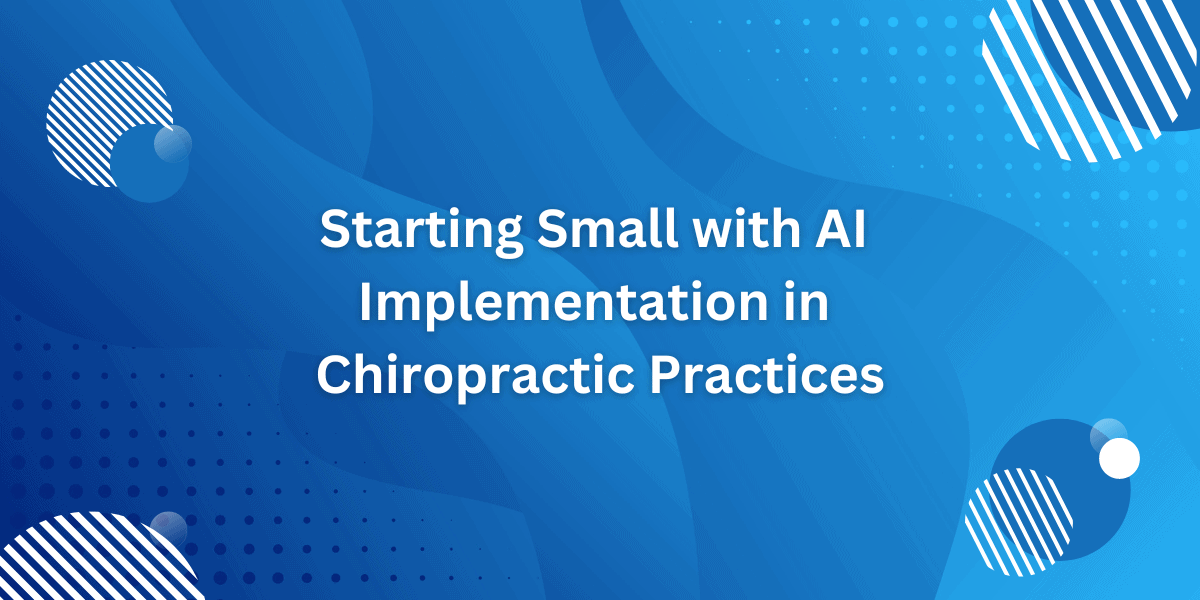In the journey of integrating Artificial Intelligence (AI) into your chiropractic practice, one of the most crucial steps is to start small.
This approach allows you to gradually introduce AI technologies, learn from the process, and scale up effectively.
Let’s explore why starting small is essential and how you can implement AI for Chiropractors services.
The Importance of Starting Small with AI for Chiropractors Services
Implementing AI in your chiropractic practice is not about making a dramatic overnight change.
It’s a process of gradual integration and adaptation. Here’s why starting small is so important:
- Manageable Learning Curve: AI systems, while designed to be user-friendly, still require some learning. By starting with one or two areas, you and your staff can focus on mastering these systems without feeling overwhelmed.
- Minimal Disruption: Introducing new technology can temporarily disrupt your workflow. By implementing AI in limited areas, you minimize this disruption and maintain the smooth operation of your practice.
- Cost-Effective: Starting small allows you to invest in AI solutions incrementally, spreading the cost over time rather than requiring a large upfront investment.
- Easier Evaluation: With a focused implementation, you can more easily assess the impact of AI on specific areas of your practice, making it simpler to calculate ROI and decide on further investments.
- Builds Confidence: Success in one area can build confidence among you and your staff, making everyone more open to further AI integration in the future.
Choosing Your Starting Point
When deciding where to begin your AI implementation, consider these high-impact, relatively easy-to-implement options:
1. AI-Powered Scheduling System
An AI scheduling system can be an excellent starting point. These systems can:
- Automatically book appointments based on your availability and patient preferences
- Send reminders to reduce no-shows
- Reschedule appointments when cancellations occur
- Predict busy periods to optimize your schedule
Implementation Tips:
- Look for systems that integrate with your existing practice management software
- Ensure the system allows for easy manual overrides when needed
- Start by using it for new patients, then gradually transition existing patients
2. Billing Automation Tool
Billing is often a pain point for chiropractic practices. An AI billing tool can:
- Automate coding based on treatment notes
- Check insurance eligibility in real-time
- Predict and prevent claim denials
- Generate and send invoices automatically
Implementation Tips:
- Begin with a subset of your billing, such as a specific insurance provider or type of treatment
- Closely monitor the accuracy of the AI system, especially in the early stages
- Gradually increase the volume of billing handled by the AI as you gain confidence in its accuracy
3. Patient Intake and History Collection
AI can streamline the patient intake process by:
- Creating dynamic digital intake forms
- Analyzing patient-reported symptoms and history
- Flagging potential issues for your attention
- Suggesting relevant follow-up questions based on patient responses
Implementation Tips:
- Start with new patients to avoid disrupting established routines
- Use a tablet or kiosk in your waiting room for patients who prefer to fill out forms on-site
- Ensure the system integrates seamlessly with your electronic health records (EHR)
Implementation Strategy: A Step-by-Step Approach
Once you’ve chosen your starting point, follow these steps for a smooth implementation:
Step 1: Set Clear Objectives
Before implementing any AI system, clearly define what you hope to achieve. For example:
- Reduce scheduling errors by 50%
- Decrease time spent on billing by 3 hours per week
- Improve the accuracy of patient history collection by 30%
Having clear, measurable objectives will help you evaluate the success of your implementation.
Step 2: Choose the Right Solution
Research different AI solutions that address your chosen area. Consider factors such as:
- Ease of use
- Integration capabilities with your existing systems
- Cost (including any ongoing fees)
- Customer support and training offered
- Reviews from other chiropractic practices
Don’t hesitate to request demos or free trials to get a feel for different systems.
Step 3: Prepare Your Team
Your staff’s buy-in is crucial for successful implementation. Here’s how to prepare them:
- Communicate the reasons for implementing AI and the benefits it will bring
- Address any concerns or fears about job security
- Provide comprehensive training, including hands-on practice with the new system
- Designate a “champion” on your staff who can become an expert in the new system and support others
Step 4: Plan the Transition
Create a detailed plan for transitioning to the new AI system. This might include:
- Setting up the new system alongside your existing one
- Running both systems in parallel for a short period
- Gradually increasing the volume of work handled by the AI system
Step 5: Monitor and Adjust
Once you’ve implemented the AI system, closely monitor its performance:
- Regularly check if you’re meeting the objectives you set in Step 1
- Solicit feedback from your staff and patients
- Identify any issues or bottlenecks and address them promptly
- Be prepared to make adjustments to your processes or the AI system itself
Step 6: Evaluate and Plan Next Steps
After a predetermined period (e.g., 3 months), conduct a thorough evaluation:
- Assess whether you’ve met your objectives
- Calculate the ROI of the AI implementation
- Identify any unexpected benefits or challenges
- Use these insights to plan your next steps, whether that’s expanding the use of your current AI system or implementing AI in another area of your practice
Case Study: Dr. Smith’s Chiropractic Clinic
To illustrate this process, let’s look at a hypothetical case study:
Dr. Smith, a chiropractor with a busy solo practice, decided to start small by implementing an AI-powered scheduling system. Her objectives were to reduce no-shows by 30% and free up 5 hours per week of her receptionist’s time.
She chose a user-friendly system that integrated with her existing practice management software. Dr. Smith involved her receptionist in the selection process and provided comprehensive training.
They started by using the AI system for new patient appointments only. After two weeks of running both systems in parallel, they transitioned all scheduling to the AI system.
After three months, Dr. Smith evaluated the results:
- No-shows had decreased by 35%, exceeding her goal
- Her receptionist was saving 6 hours per week on scheduling tasks
- An unexpected benefit was that the AI system’s reminders had increased patient satisfaction
Based on this success, Dr. Smith planned her next AI implementation: a billing automation tool to streamline her insurance claims process.
Conclusion
Starting small with AI implementation in your chiropractic practice is a strategic approach that allows for gradual, manageable change.
By focusing on one or two key areas initially, you can learn how to work with AI systems, see tangible benefits, and identify any challenges before committing to wider implementation.
Remember, the goal of AI in your practice is not to replace the human touch that’s so crucial in chiropractic care.
Instead, it’s about enhancing your capabilities, streamlining your operations, and ultimately allowing you to focus more on what matters most: providing excellent care to your patients.
As you embark on your AI implementation journey, keep an open mind, stay patient, and be willing to learn and adjust as you go.
With this approach, you’ll be well-positioned to harness the power of AI to improve your practice, one small step at a time.





